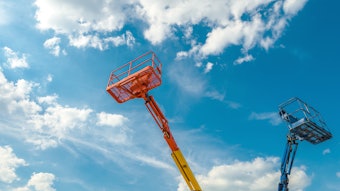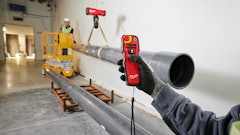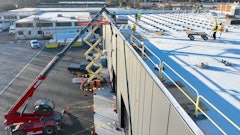
By: Jim Eple
Over the past few years, lift equipment such as aerial work platforms and telescopic handlers have gone through a transformation. Rather than serving as simple transport devices, they have evolved into multi-tasking tools that deliver added ROI, while providing workers with safer alternatives to complete a variety of tasks. Following is a look at some of the more recent options and attachments available to help you maximize the productivity and safety of your overhead operations.
Integrating power into AWPs
Overhead work on building sites encompasses a multitude of activities, such as welding, glazing, painting, wiring, maintenance, etc. Workers often need to take tools with them in the aerial work platform, or use auxiliary power sources to perform various tasks. Doing so enhances productivity, but can also compound the potential safety risks.
According to Tony Groat, North American membership development director, Aerial Work Platform Training (AWPT), a national safety training organization, the use of auxiliary tools can lead to increased congestion of both the platform and the ground below it. There is also a risk of exceeding the lift’s rated capacity, as well as entangling or snagging lines extending down from the platform.
To optimize equipment versatility while addressing safety concerns, manufacturers are offering attachments and/or work stations specifically for aerial lifts. The simplest of the attachments include fluorescent tube caddies, pipe racks and specialized cradles for glass and panels that are installed on the platform’s rails. There are also a variety of tool trays that can include a vise, tool and parts holders, 12-volt outlet to recharge battery-operated hand tools and electrician’s trees to hold wire spools.
“Factory-approved options and work stations greatly enhance the safety and productivity of the platform operator and those in the work area,” Groat points out. “Fully integrated tools improve machine mobility and accessibility for the operator.”
Manufacturers are also routing air and electrical lines through the boom to the platform, with quick connects at the base. Compressors and generators can be attached to the machine at the base with outlets at the platform.
Incorporating electric, air and water lines inside the boom allows powered tools to be safely operated from the platform, Groat states. It eliminates any tethering lines draped over the platform railing to a separate machine on the ground, where they can become a hazard to moving vehicles and ground personnel.
But there is a drawback. Work must stop each time the aerial work platform is moved to allow the ground-based generator or compressor to be moved, as well.
To overcome this mobility issue, many aerial lift equipment suppliers offer generators integrated into the engine compartment and powered with a hydraulic or belt link to the engine. Many also offer integrated welding units to accompany the generators.
Integrated generators have become so popular, they are now included on the majority of the lifts JLG sells. “Our SkyPower 7,500-watt generators are sold on most combustion-powered boom lifts and are standard equipment on 120- and 135-ft. platform height boom lifts,” says Howard Kaplan, JLG vice president and product parent. “On the 60-ft. and under boom lifts, either the 7,500-watt generator or a smaller generator are options.”
JLG also offers an optional air compressor for its boom lifts that can be installed in the engine compartment and is powered by the generator. It delivers 9.3 cfm of air at 125 psi.
Generators aren’t the only option available for Genie’s combustion-powered and electric-powered boom lifts. “Genie offers an optional 800-watt inverter that converts 48V DC to 120V AC power to allow operators to utilize a variety of power tools on the platform,” says Phil Harvey, boom lift product manager.
A 110V/60-Hz inverter is also available on all Genie electric scissor lifts, with an additional 230V/50-Hz inverter choice available for the two largest units, says Eric Ludwig, scissor lift product manager. On combustion engine models, there is an optional 2,000-watt generator. For the largest rough-terrain models, a welder option incorporates a 12,500-watt generator.
Skyjack also offers various power options on its new boom lifts. There is a basic 3,500-watt generator, plus a step-up option for a welder-ready machine that includes a 12,000-watt hydraulic generator with an oil cooler. For electric-powered scissor lifts, there is an optional 800-watt AC inverter and shop air line to the platform. Rough-terrain scissor lifts offer the shop air line, inverter and a 2,000-watt hydraulic generator.
Telehandlers as personnel lifts
Attachments are enabling telehandlers to expand their role on construction sites, as well. A number of attachments are available, such as brooms, truss booms, buckets and shovels. But for overhead work, the personnel work platform is the ideal accessory.
Dedicated boom or scissor lifts remain the preferred choice for most overhead tasks. Yet, there are circumstances where a telehandler equipped with a personnel work platform can be a viable option. For example, in extremely rough-terrain and/or sloping ground conditions, a telehandler can be used to lift workers to hard to reach areas that would be difficult or impossible to access with a boom lift. There may also be situations where it’s more cost effective or practical to simply swap out attachments, rather than bring both a telehandler and a boom lift to the jobsite.
Several independent manufacturers make personnel work platforms that fit on the forks of a telehandler. They are also offered by Gehl, JLG and Manitou for their own brands. Before buying any personnel work platform, determine whether the unit complies with ANSI/ITSDF B56.6-2005 standards.
Manitou offers four models of personnel work platforms for its rotating turret telehandlers (the cab and boom rotate as a unit). The platforms are internally wired with programming to operate the boom and safety features, such as lowering the boom if there is an engine failure. They also have a kill switch to stop all operations. According to Ryan Ford, Manitou construction telehandler specialist, 95% of the rotating turret telehandlers are purchased with the platform predispositioned, plus a control box.
Manitou also offers a fork-mounted platform for its conventional series of telehandlers with optional 180° swing carriage and wireless remote control boom. It does not allow the use of platforms on its lift trucks except for these specific models, and only when equipped with all of the required safety systems.
Gehl offers a fork-mounted personnel work platform, as well as two specialized platforms. One is a 180° swing work platform directly mounted on the boom. It allows workers to adjust the location of the platform to a comfortable and safe working position, even if the telehandler may not be able to be positioned correctly due to situations on the ground. The specialized platforms allow the worker in the platform to safely start/stop the telehandler’s engine, as well as raise/lower and extend/retract the boom without requiring a second operator to be in the cab of the machine.
JLG’s standard personnel work platform fits over the forks of all four of its telehandler brands (JLG, Gradall, Lull and SkyTrak). It features a removable front panel to allow operators to more easily get materials into and out of the platform. There is also a quick-switch model available for the JLG and Gradall brands that allows a rapid change from forks to a platform that directly attaches to the boom.





























